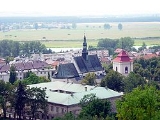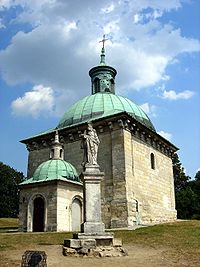
Pinczów
Encyclopedia

Poland
Poland , officially the Republic of Poland , is a country in Central Europe bordered by Germany to the west; the Czech Republic and Slovakia to the south; Ukraine, Belarus and Lithuania to the east; and the Baltic Sea and Kaliningrad Oblast, a Russian exclave, to the north...
, in Świętokrzyskie Voivodship, about 40 km south of Kielce
Kielce
Kielce ) is a city in central Poland with 204,891 inhabitants . It is also the capital city of the Świętokrzyskie Voivodeship since 1999, previously in Kielce Voivodeship...
. It is the capital of Pińczów County
Pinczów County
Pińczów County is a unit of territorial administration and local government in Świętokrzyskie Voivodeship, south-central Poland. It came into being on January 1, 1999, as a result of the Polish local government reforms passed in 1998. Its administrative seat and largest town is Pińczów, which...
. Population is 12,304 (2005).
History
The history of the town dates back to the 12th century's quarry and, today ruined, 13th century's castle.The Calvinist nobleman Nicholas Oleśnicki drove out the Catholic monks of Pińczów in 1550 at the instigation of the Italian ex-priest Francesco Stancaro
Francesco Stancaro
Franciscus Stancarus was an Italian priest, professor of Hebrew at the University of Königsberg.He engaged in debate with Jan Laski and Peter Martyr Vermigli.- References :...
, creating a Calvinist centre, where the Synods of Pińczów
Synods of Pińczów
The Synods of Pińczów were a series of 22 Calvinist synods held in the town of Pińczów from 1550-1563.At the time of the Reformation Pińczów belonged to a Calvinist nobleman, Nicholas Oleśnicki, and was one of the centers of Calvinism and Arianism in Poland. Synods were held in the former Pauline...
were held 1550-1563. Pińczów is sometimes called the "Sarmatian Athens" for its association with the Calvinist Academy founded by Francesco Lismanino
Francesco Lismanino
Francesco Lismanino , Italian-Polish Franciscan.Lismanino came as a child to Kraków, but returned as a teenager to Italy to study, where he entered the Franciscan order. In 1533 he returned to the Italianate court of Bona Sforza in Kraków, where he was later cantor, and confessor to the queen...
, to which scholars such as the French grammarian Pierre Statorius
Pierre Statorius
Pierre Statorius was a French grammarian and theologian, who settled among the Polish Brethren, becoming rector of a the Calvinist Academy in Pińczów at the invitation of Francesco Lismanino....
were invited. The town was the site of the six years of work 1558-1563 for the translators of the Brest Bible
Brest Bible
The Brest Bible was the first comprehensive Polish language Protestant Bible translation, published in 1563 in Brest and dedicated to King Sigismund II Augustus....
, which is why the Bible is sometimes called the Biblia Pińczowska.
During the 18th century the town was seat of the Wielopolscy family.
Pińczów was destroyed by Germans in September 1939 and almost all Jews, who had accounted for about 70% of the town's population, were killed or sent to extermination camps. Most Pińczów's Jews were dead in the death camp Treblinka. The Jewish cemetery was also destroyed. Some Jews of Pińczów survived the Holocaust by hiding in nearby forests. Some, though not many, were hidden by Polish farmers until the end of the war.
The Republic of Pińczów
Republic of Pinczów
Republic of Pińczów was a name of short-lived entity in Świętokrzyskie Voivodeship liberated by joint forces of polish Resistance formations: Home Army, People's Army and Peasants' Battalions, during a period from July 21 to August 12, 1944....
was a short-lived uprising.
Main sights
The town's attractions include the 18th century palace of the Wielkopolscy family, several churches and monasteries (some dating back to 15th century), the Renaissance St. Anne's Chapel, the recently restored synagoguePinczów synagogue
Pińczów synagogue is a Jewish synagogue in Pińczów in Poland.It is one of the oldest synagogues in Poland, built in 1594-1609. The designer was probably the Florentian Santi Gucci. During World War II it was vandalized by the Nazi Germans, then damaged during fighting in 1944, and it is inactive...
, and ruins of the 13th century castle.

